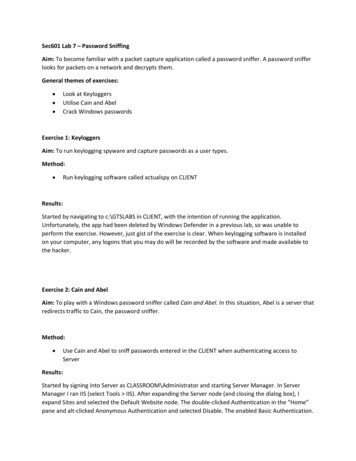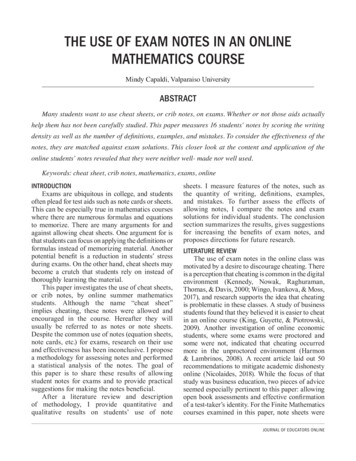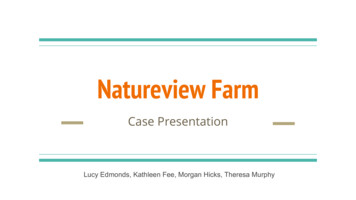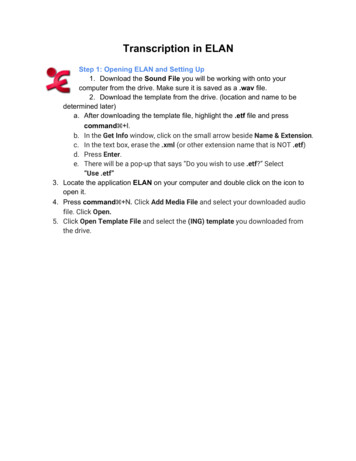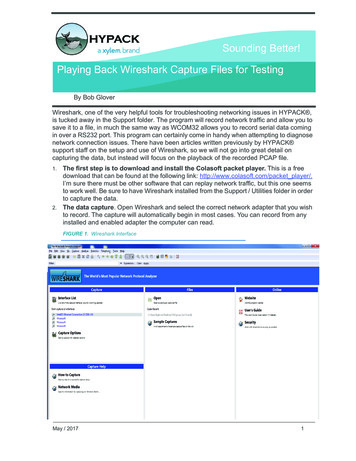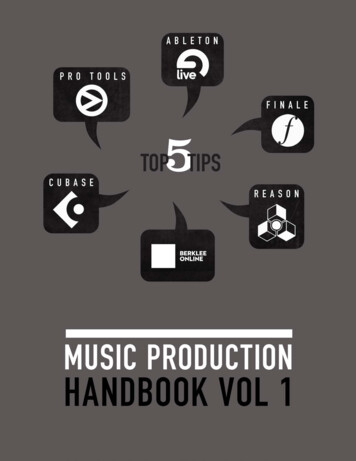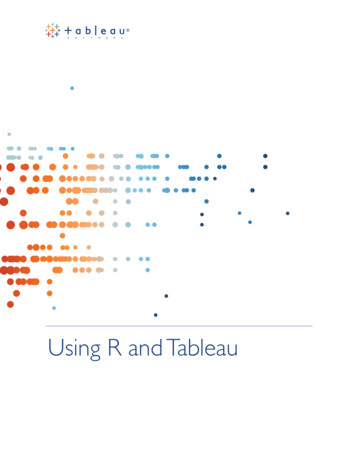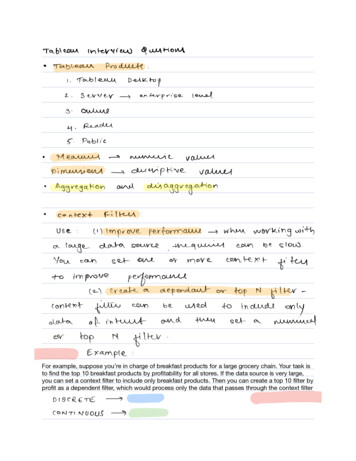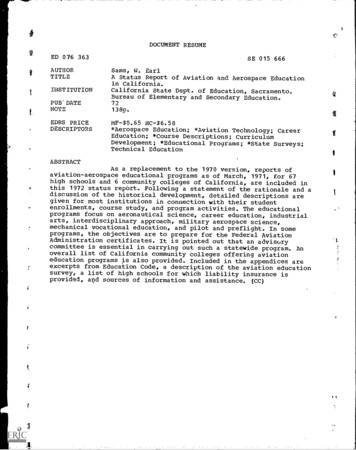
Transcription
iDOCUMENT RESUMEED 076 363AUTHORTITLEINSTITUTIONPUB' DATENOTEEDRS PRICEDESCRIPTORSSE 015 666Sams, W. EarlA Status Report of Aviation and Aerospace Educationin California.California State Dept. of Education, Sacramento.Bureau of Elementary and Secondary Education.72138p.MF- 0.65 HC- 6.58*Aerospace Education; *Aviation Technology; CareerEducation; *Course Descriptions; CurriculumDevelopment; *Educational Programs; *State Surveys;Technical EducationtIIABSTRACTAs a replacement to the 1970 version, reports ofaviation-aerospace educational programs as of March, 1971, for 67high schools and 6 community colleges of California, are included inthis 1972 status report. Following a statement of the rationale and adiscussion of the historical development, detailed descriptions aregiven for most institutions in connection with their studentenrollments, course study, and program activities. The educationalprograms focus on aeronautical science, career education, industrialarts, interdisciplinary approach, military aerospace science,mechanical vocational education, and pilot and preflight. In someprograms, the objectives are to prepare for the Federal AviationAdministration certificates. It is pointed out that an advisorycommittee is essential in carrying out such a statewide program. Anoverall list of California community colleges offering aviationeducation programs is also provided. Included in the appendices areexcerpts from Education Code, a description of the aviation educationsurvey, a list of high schools for which liability insurance isprovided, akid sources of information and assistance. (CC)1I'I.;i\
9(9/.0 03
'l't1.DCDi.A STATUS REPORT OF AVIATIONAND AEROSPACE EDUCATION IN CALIFORNIAwPrepared for theBureau of Elementary and Secondary EducationDivision of InstructionBy W. EARL SAMSConsultant in Secondary Education
This publication, which was produced with federal funds,was published by the California State Department of Education, 721 Capitol Mall, Sacramento, California 95814.Printed by the Office of State Printingand distributed under the provisions ofthe Library Distribution Act1972ii
FOREWORDThe demand for better trained and better educated personnel in everyaspect of air transportation today gives justifiable impetus to thoseschools and colleges that are evaluating existing programs or designingnew ones.Our statewide advisory committee and the Governor's Aerospace EducationTask Force have re* ,mmended studies in all categories of aviation andaerospace education to determine the needs for education and for training. ,Both groups have recognized the need for relevant integration ofbasic elements of science and mathematics in aviation-aerospace curriculum and the potentialities of such studies in basic skill programs.The California schools and colleges which are close to the 167 airportsbeing used for pilot training have the advantage of a working model ofan aviation-aerospace education laboratory. I believe that an adequateprogram of aviation-aerospace education in California will (1) help theyouth of this state discover how to use aircraft effectively; (2) helpyouth prepare for careers in aviation and space science; (3) assistcommunities in the development of facilities needed for a comprehensiveair transportation system; and (4) help schools discover how to utilizethe interest of youth in aviation and space operations.We are grateful to all California public schools and colleges whichhave cooperated in helping us produce this resume of the course offeringsin aviation, aeronautical science, and the aerospace sciences. Thepublication will serve as a guide for those schools and colleges thatare planning new programs or attempting to strengthen existing ones.Superintendent of Public Instructioniii
74'Dr. Wilson Riles, California Superintendent of Public Instruction, extends aCertificate of Appreciation to Congressman Don H. Clausen for his support of aerospace education and congratulates him for having had the foresight to help theschools of Crescent City establish an aviation education program in 1951 that hashelped many youths find careers in air transportation and general aviation.iv
PREFACEThis publication is a report of the status of aviation and aerospaceeducation in the schools and colleges of California.However, since theCalifornia community colleges are no longer under the jurisdiction of theState Board of Education, only representative course descriptions forcommunity colleges are included. This report contains summaries of 67high school and six community college programs of aviation-aerospaceeducation.Resources that can provide detailed information about all ofthe aviation and aerospace instruction in California are identified inthis document.Aviation education in California has experienced many successes and manyfailures.Since the inception of aviation education in 1946, the statewide efforthas been toward identifying the historical developments in the field.Some aviation instruction was offered in a Los Angeles high school in1919, but it was the San Francisco School District that started a highschool program in aviation education in 1939 that has continued. Manyhigh schools established sound aviation programs in 1946.Palo Alto isone that has persisted, while many other districts have temporarilyabandoned the aviation course. Reedly College reported the earliestknown program in the 1920s; and during the 1930s, Sacramento City Collegeand the College of San Mateo began instruction in aeronautics.The interest of students in aviation, rocketry, and space explorationhas resulted in some specialized courses designed to prepare students forcareers in those fields. This publication contains brief reports of manysuch programs.Aviation and aerospace study lends itself naturally to interdisciplinaryproject-oriented courses.Coordinated programs in grades ten throughfourteen are finding greater acceptance in the districts of the state.Direct contact with industry, through advisory committees, and constantcurriculum modernization are essential for a current up-to-date aviationcurriculum.Sources for textbooks and other instructional materials and reference tocurrent California Education Code provisions are included in the Appendix.The names of some members of the former advisory committee to theSuperintendent of Public Instruction have been included, although thecommittee has been officially disbanded. The listing includes only thosepeople who have registered a willingness to provide continued service andcounsel.THOMAS A SHELLHAMMERDeputy Superintendent for. ProgramsMITCHELL L. VOYDAT, ChiefBureau of Elementary andSecondary EducationV
SPECIAL RECOGNITIONSpecial recognition for extensive service and promotional efforts in behalfof aviation and aerospace education in California are due:1.Congressman Don H. Clausen for having initiated the program inDel Norte High School, Crescent City, in 1951, continuing hisnational efforts to help schools discover the educationalpotentialities in such a program preparing our youth to meet thejet-space-nuclear challenges and opportunities.2.Bertrand Rhine, Attorney, former Wing Commander of Civil Air Patrol, for the CAP-sponsored legislation in 1945 which forced theState Department of Education to help school districts establishand maintain such programs and for his continued effort to promote general aviation as an educational resource.3.L. W. Hunt, President, and Harry Noblitt, Vice President, ofAirfliie, Inc., for their unprecedented support of the state'saviation education efforts, beginning in 1946.4.Stewart Angle, Chairman, Aviation Department, Mt. San AntonioCollege, for his persistent efforts to extend aviation and airtransportation education to men and women students seekingcareers in the industry and for introducing California to theversatility of air transportation as a flying classroom.5.William D. Hecht, United Air Lines (retired), for making theeducational services of UAL available to sJiools and collegesfor 25 years and for his persistent suppol. of the CaliforniaAviation Education Association after retirement.6.Eugene Kropf of the Federal Aviation Administration for hisuntiring support of California's aviation education endeavors.7.Thomas Leonard, Chairman, Department of Aeronautics, San JoseState College, for accomplishing the impossible in the development of one state college aviation and aerospace educationairport department against seemingly insurmountable odds.8.Ted G. Misenhimer, Instructor, Redondo High School, for developing and maintaining a model aviation and aeronautical sciencehigh school program which has been the inspiration for hundredsof school administrators and teachers throughout the nation.vii
CONTENTSForewordiiiPrefaceSpecial RecognitionviiRationale for AviationAerospace Education1(Includes list of names and addresses of those members of the formerCalifornia Aerospace Education Advisory Committee who have expressedwillingness to continue service in an unofficial advisory capacity)California High Schools Offering Aviation Education ProgramsDescriptions of High School Aerospace and Aviation Education ProgramsAnderson High School, AndersonAnderson Valley High School, BoonvilleAragon High School, San MateoArcadia High School, ArcadiaAviation High School, Redondo BeachBolsa Grande High School, Garden GroveBurbank Senior High School, SacramentoChester High School, ChesterClaremont High School, ClaremontCleveland High School, ResedaClovis High School, ClovisCompton High School, ComptonCosta Mesa High School, Costa MesaCulver City High School, Culver CityDavis High School, ModestoDel Norte High School, Crescent CityDixon High School, DixonDominguez High School, ComptonDowney High School, DowneyEisenhower High School, RialtoEl Dorado High School, PlacentiaElk Grove High School, Elk GroveFairfield High School, FairfieldFresno High School, FresnoGranada High School, LivermoreHoover High School, GlendaleLos Angeles City Schbols, Los AngelesLower Lake High School, Lower LakeManual Arts High School, Los AngelesMarysville High School, MarysvilleMendocino County Schools, UkiahMenlo Atherton High School, AthertonMonterey Peninsula Unified School District, MontereyMoreno Valley High School, SunnymeadNewport-Mesa Unified School District, Newport BeachNovato High School, NovatoO'Connell Vocational High School and Technical Institute, San 4242444646484850515152535556565959606163
Palm Springs High School, Palm SpringsPalo Alto High School, Palo AltoPerris Union High School District, PerrisPleasant Hill High School, Pleasant HillPlumas Unified School District, QuincyPortola High School, PortolaQuincy High School, QuincyRavenswood High School, East Palo AltoRedlands High School, RedlandsRedondo High School, Redondo BeachRichmond Unified School District, RichmondSacramento County Regional Occupational Center, SacramentoSan Antonio High School, ClaremontSan Mateo County Board of EducationRegicnal Training Program, Redwood CitySanta Rosa High School, Santa RosaSeaside High School, MontereySerrano Junior High School, San BernardinoStagg High School, StocktonTahoe Truckee High School, TruckeeTehachapi High School, TehachapiTulare High School, TulareValencia High School, PlacentiaVerdugo Hills High School, TujungaVista High School, VistaWashington High School, San FranciscoWilson High School, Long BeachWoodland High School, 0929394959596Aviation Education in the Community Colleges of CaliforniaCalifornia Community Colleges Offering Aviation Education ProgramsSelected Descriptions of Community College ProgramsChaffey Community College, Alta LomaCollege of San Mateo, San Mateo. ,Foothill College, Los AltosMount San Antonio College, WalnutReedley College, ReedleySan Bernardino Valley College Regional Training Program,San BernardinoAppendixExcerpts from Education CodeAviation Education SurveyCalifornia High Schools Offering Aviation EducationPrograms for Which Liability Insurance is ProvidedSources of Aviation Education 23125
RATIONALE FOR AVIATION- AEROSPACE EDUCATIONAmong the many reasons for an aviation-aerospace educational program, threerate prime consideration at the high school level.(1)Many high schools haveincreased their holding power over potential dropouts with aviation aerospaceeducational programs.(2)Many airports are good educational laboratories.(3)Career opportunities in general aviation (aircraft design, constructionand operation), air transportation and aerospace industries are revealed bysuch instruction.Other good reasons for such programs are that (1) there is a continuing needfor more and better educated and trained individuals in most aspects of aviation, air transportation, aeronautics, and aerospace operations; (2) the livesof the pilot and his passengers are completely dependent upon his training,integrity, attitude, and capability; and (3) many dads--and teachers--havediscovered that basic flight instruction of a son or daughter can be a powerful "generation gap" reducer.In this account, we have included 67 high schools and six colleges that havereported they offered aviation programs as of March, 1971.We have identifiedsome schools that lost their instructor and have only temporarily eliminatedthe program.(Attention: prospective aviation educators!) Most of the schoolsand colleges with aviation education programs are within five miles of an airport (one rural high school built its own bordering the campus). Most of themuse live aircraft in their operations. The names of persons to be contactedfor additional operational information are included.Details regarding unique aviation course offerings are included because of themany requests from educators contemplating a new program. Requests for information are also received from air transport personnel, aircraft manufacturers,and governmental agencies -esponsible for aviation safety.As of January, 1972,we had requests from 39 community colleges and 288 high schoolsin Californiafor current aviation education information.It is probable that approximately200 schools and colleges are offering ground school courses for pilots in regular and adult education programs throughout the state.No attempt is made atthis time to list all of those programs.(See Survey Results in Appendix forFederal Aviation Administration testing and career education information.)Some of the most frequently asked questions and answers include the following:1.How many schools and colleges overcome fear of liability?Many California schools and colleges have solved the "fear of liat.flity"problem by obtaining supplementary liability insurance to cover the standard policies.How much liability insurance is adequate depends upeo thecommunity and the circumstances.Some colleges, it will be observed iyomthe reports contained herein, consider 500,000 to be adequate (especiallywhen at any one time the lives of only one student and one instructor aresubjected to the hazard). Others require as much as 2,000,000 supplemental liability insurance because four-place aircraft are used for theprogram.(See Survey Results in Appendix regarding insurance.)2.How have schools covered the costs of the flight programs?Some have had support of Rosenberg, Bates, and other foundations. The costof the aircraft operation and liability insurance coverage, in most cases,is borne indirectly by the students who engage in the flight activities.1
2whether they use the flight services ora school or college club or takethe flight instruction in aircraft provided by a private flight school operator.Some colleges have entered into contracts with one or more flightschool operators to guarantee a quality program of flight instruction atnominal cost. Standards of safety and quality that exceed the minimumsspecified by the Federal Aviation Administration are the result. (FAA suggests that public schools and colleges should have better than minimumstandards.)3.How can we get help setting up a new program or strengthening an ailing one?The cooperative attitude among most high school and community college aviation educators in California has provided a valuable, continuing source ofconsultant and advisory service to the schools and colleges. These aviationeducators founded thd California Aerospace Education Association (CAEA) in1950 (incorporated in 1954), for the prime purpose of helping each other.Some of the past presidents are: ('67-68) Stewart Angle, Mt. San AntonioCollege, 1100 North Grand Avenue, Walnut, CA 91789, Tel. (213) 339-7331;('68-69) Myrl Rupel, Superintendent, Perris Union High School District,350 East Fourth Street, Perris, CA 92370, Tel. (714) 657-5138; ('69-70)Mrs. June Edwards, Agricultural Aviation Consultant, author, pilot, andKern County Schools Aviation Education Consultant, 3100 Durwood, Bakersfield, CA 93304, Tel: (805) 832-1756 or 832-3111, cxt. 100; and ('70-71)Robert Ring, San Jose State College, 125 South Seventh, San Jose, CA95114, Tel: (408) 294-6414.The current president is Mrs. Nancy Harker,550-D East Olive Avenue, Burbank, CA 95114, Tel: (213) 843-5395.The aims of the CAEA are:4.a.To aid in the development and improvement of aerospace curricula in theschools of Californiab.To promote closer affiliation between educational institutions and theaerospace industry so that programs of education may better providefor Cie needs of the industryc.To promote greater cooperation and interchange of ideas among theteaching and administrative personnel of the schools participating inaerospace educationd.To recognize outstanding students interested in aerospace through themedium of an annual Air Youth Daye.To encourage younger students in science and mathematics to participatein aviation activitiesWhat are the legal provisions for aviation education?The existing Education Code provisions pertaining to aviation educationwere worked out cooperatively by Senator Stephen P. Teale and the CAEA.They have been used to provide nominal consultant service from the StateDepartment of Education and are also used by some districts to suggest thecoordinated approach to aviation education from the elementary level throughthe higher level of education in the community colleges.The code provisions are provided for reference in the Appendix.From the variety of aviation education programs described by the communitycolleges, it will be observed that a multitude of possibilities are availFor example, the Diablo Valley College, with itsable to any district.
3approximate enrollment of 168 students last year, had only one teacher,Mrs.Coral Bloom, who did all of the ground instruction and most of the flightinstruction as well. The college has made no effort to provide the aviationmechanics program because they have felt other districts were more adequately equipped to fulfill that need. At the other end of the spectrum, we havesuch programs at the college level with approximately 1,000 students and 15fulltimeequivalent instructors in aeronautics.The reader is invited to direct questions to the institutions whose aviationprograms are listed in this report. However, all who are engaged in theprocess of developing a new program or strengthening an existing one areurged to become thoroughly familiar with the related materials reported bythe high schools and colleges. They should also plan to visit the most representative program to witness it in operation before directing an extensivelist of questions to the cooperating institutions. Inasmuch as thousands ofhours of research have gone into the development of successful programs. theycan best be understood by a personal visit followed by an analysis of thecurriculum and operational materials provided.The increasing interest in flight programs at the community college levelhas produced a renewed interest in the legal provisions for such p
Aviation Education in the Community Colleges of California. 99. California Community Colleges Offering Aviation Education Programs. . 100. Selected Descriptions of Community College Programs. 103. Chaffey Community College, Alta Loma. 104. College of San Mateo, San Mateo., 105. Foothi
